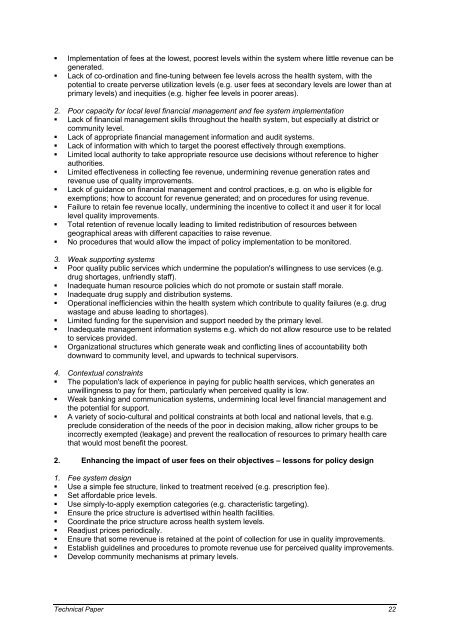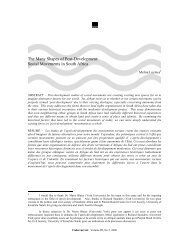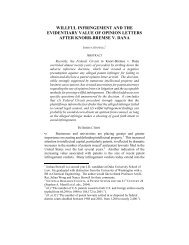equity implications of health sector user fees in tanzania
equity implications of health sector user fees in tanzania
equity implications of health sector user fees in tanzania
You also want an ePaper? Increase the reach of your titles
YUMPU automatically turns print PDFs into web optimized ePapers that Google loves.
� Implementation <strong>of</strong> <strong>fees</strong> at the lowest, poorest levels with<strong>in</strong> the system where little revenue can be<br />
generated.<br />
� Lack <strong>of</strong> co-ord<strong>in</strong>ation and f<strong>in</strong>e-tun<strong>in</strong>g between fee levels across the <strong>health</strong> system, with the<br />
potential to create perverse utilization levels (e.g. <strong>user</strong> <strong>fees</strong> at secondary levels are lower than at<br />
primary levels) and <strong>in</strong>equities (e.g. higher fee levels <strong>in</strong> poorer areas).<br />
2. Poor capacity for local level f<strong>in</strong>ancial management and fee system implementation<br />
� Lack <strong>of</strong> f<strong>in</strong>ancial management skills throughout the <strong>health</strong> system, but especially at district or<br />
community level.<br />
� Lack <strong>of</strong> appropriate f<strong>in</strong>ancial management <strong>in</strong>formation and audit systems.<br />
� Lack <strong>of</strong> <strong>in</strong>formation with which to target the poorest effectively through exemptions.<br />
� Limited local authority to take appropriate resource use decisions without reference to higher<br />
authorities.<br />
� Limited effectiveness <strong>in</strong> collect<strong>in</strong>g fee revenue, underm<strong>in</strong><strong>in</strong>g revenue generation rates and<br />
revenue use <strong>of</strong> quality improvements.<br />
� Lack <strong>of</strong> guidance on f<strong>in</strong>ancial management and control practices, e.g. on who is eligible for<br />
exemptions; how to account for revenue generated; and on procedures for us<strong>in</strong>g revenue.<br />
� Failure to reta<strong>in</strong> fee revenue locally, underm<strong>in</strong><strong>in</strong>g the <strong>in</strong>centive to collect it and <strong>user</strong> it for local<br />
level quality improvements.<br />
� Total retention <strong>of</strong> revenue locally lead<strong>in</strong>g to limited redistribution <strong>of</strong> resources between<br />
geographical areas with different capacities to raise revenue.<br />
� No procedures that would allow the impact <strong>of</strong> policy implementation to be monitored.<br />
3. Weak support<strong>in</strong>g systems<br />
� Poor quality public services which underm<strong>in</strong>e the population's will<strong>in</strong>gness to use services (e.g.<br />
drug shortages, unfriendly staff).<br />
� Inadequate human resource policies which do not promote or susta<strong>in</strong> staff morale.<br />
� Inadequate drug supply and distribution systems.<br />
� Operational <strong>in</strong>efficiencies with<strong>in</strong> the <strong>health</strong> system which contribute to quality failures (e.g. drug<br />
wastage and abuse lead<strong>in</strong>g to shortages).<br />
� Limited fund<strong>in</strong>g for the supervision and support needed by the primary level.<br />
� Inadequate management <strong>in</strong>formation systems e.g. which do not allow resource use to be related<br />
to services provided.<br />
� Organizational structures which generate weak and conflict<strong>in</strong>g l<strong>in</strong>es <strong>of</strong> accountability both<br />
downward to community level, and upwards to technical supervisors.<br />
4. Contextual constra<strong>in</strong>ts<br />
� The population's lack <strong>of</strong> experience <strong>in</strong> pay<strong>in</strong>g for public <strong>health</strong> services, which generates an<br />
unwill<strong>in</strong>gness to pay for them, particularly when perceived quality is low.<br />
� Weak bank<strong>in</strong>g and communication systems, underm<strong>in</strong><strong>in</strong>g local level f<strong>in</strong>ancial management and<br />
the potential for support.<br />
� A variety <strong>of</strong> socio-cultural and political constra<strong>in</strong>ts at both local and national levels, that e.g.<br />
preclude consideration <strong>of</strong> the needs <strong>of</strong> the poor <strong>in</strong> decision mak<strong>in</strong>g, allow richer groups to be<br />
<strong>in</strong>correctly exempted (leakage) and prevent the reallocation <strong>of</strong> resources to primary <strong>health</strong> care<br />
that would most benefit the poorest.<br />
2. Enhanc<strong>in</strong>g the impact <strong>of</strong> <strong>user</strong> <strong>fees</strong> on their objectives – lessons for policy design<br />
1. Fee system design<br />
� Use a simple fee structure, l<strong>in</strong>ked to treatment received (e.g. prescription fee).<br />
� Set affordable price levels.<br />
� Use simply-to-apply exemption categories (e.g. characteristic target<strong>in</strong>g).<br />
� Ensure the price structure is advertised with<strong>in</strong> <strong>health</strong> facilities.<br />
� Coord<strong>in</strong>ate the price structure across <strong>health</strong> system levels.<br />
� Readjust prices periodically.<br />
� Ensure that some revenue is reta<strong>in</strong>ed at the po<strong>in</strong>t <strong>of</strong> collection for use <strong>in</strong> quality improvements.<br />
� Establish guidel<strong>in</strong>es and procedures to promote revenue use for perceived quality improvements.<br />
� Develop community mechanisms at primary levels.<br />
Technical Paper 22













